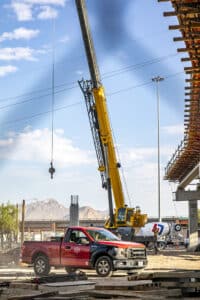For more than two decades, residents along Paisano Drive say they’ve endured idling trucks that have made it nearly impossible to get in and out of their neighborhoods. However, the $96 million I-10 Connect freeway project is delivering some relief for them as well as commuters.
In the 61½ years since she moved into her house on Latta Street, Becky Leon has seen a lot of changes.
“I was six months old when we moved into this house; it used to have a store in the front and two apartments in the back,” she said. “Interstate-110 wasn’t there; I used to walk across the street and over the canal to Zavala Elementary School.”

Construction of the short freeway spur linking US 54 to the Bridge of the Americas port of entry is just one of the changes in the neighborhood since Becky moved there as an infant. In 1962, the Chamizal Treaty moved the U.S.-México Border, the Rio Grande and the port of entry north by about a mile.
But it wasn’t until about 2000 that the border back-ups began. Truck traffic bound for México would queue up for hours along US 62 (Paisano Drive) seeking to circumvent long waits to enter the southbound customs facility. That blocked the only way in and out of Leon’s neighborhood.
“It would take us up to 45 minutes or more to get back in,” she said. “It makes you upset. You have to do everything really early in the morning or late at night.”
Leon, who retired from the U.S. Navy after 21 years, said she and her neighbors — many of whom are also her family — could anticipate the traffic flow and planned their lives around it.
 “You just didn’t want to go anywhere after noon. You just knew you wouldn’t be able to get back to your house,” she said. “It puts you on edge.”
“You just didn’t want to go anywhere after noon. You just knew you wouldn’t be able to get back to your house,” she said. “It puts you on edge.”
The I-10 Connect project which is nearing completion has already brought some relief to Leon and her neighbors. The project permanently eliminated access from Paisano Drive to the Bridge of the Americas. It will no longer be a congested shortcut for cross-border traffic.
“One major goal of the project was to minimize congestion,” said Mark Soyster, Sundt’s Transportation Group area manager in El Paso. “Having traffic flow more quickly, more easily with less idling means fewer negative economic impacts and fewer negative environmental impacts.”
Removing access from Paisano to the Bridge of the Americas is only a small part of the I-10 Connect project. Most of the project’s 16 new bridges or bridge segments are being precisely set into the existing “Spaghetti Bowl” interchange at I-10 and US 54. The new ramps will provide motorists with direct access between I-10 and Loop 375, separating it from traffic waiting on the US-110 to cross into Mexico.
While the primary goal is enabling traffic on I-10 to more effectively transfer to Loop 375 as an alternate route during construction or because of an accident, Soyster said the impact for residential areas along Paisano shouldn’t be overlooked.
“Any time you move transportation through an area quicker, it lessens the impact on the community,” he added. “The Latta neighborhood had been severely impacted. For years, they’ve lived with the congestion; they’ve lived with the trucks idling for hours on end.”
Eager to make sure the cure wasn’t worse than the disease, the Texas Department of Transportation incentivized speedy completion of the project. The desire for a fast build required some methodical planning long before ground was ever broken.
“We spent a lot of time prior to bidding looking deeply into the schedule to understand exactly how this all went together and determining how we could be the most efficient,” Soyster said. “From the tight quarters in Lincoln Park to placing cranes along live traffic, our team had to keep thinking three, four and five months down the road making sure that we didn’t box ourselves in.”
Despite that planning, the project’s location in a highly built-up, urban environment brought challenges that could have derailed the project.
“Our team kept working through issues, kept looking for ways to keep the project on track,” Soyster said. “No matter the challenges, the group stuck together and worked through it. Everybody kept looking for solutions.”
Residents like Leon are thankful they did, hoping the project brings solutions to their long-standing traffic troubles.
“We’re looking forward to it. We keep trying to picture the ultimate, the very last portion of it getting done. I just know the first couple of times I drive it, I’m gonna get lost,” she said with a laugh.
